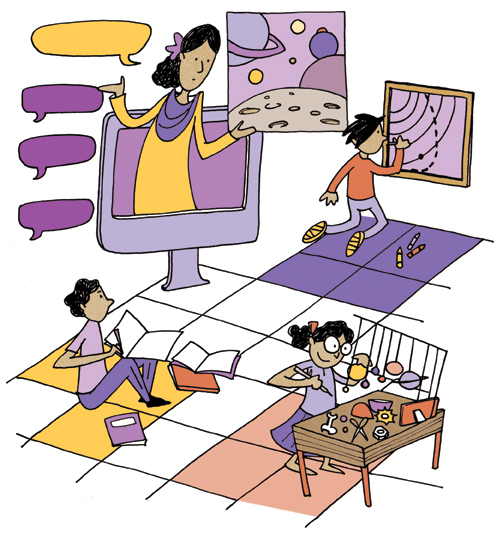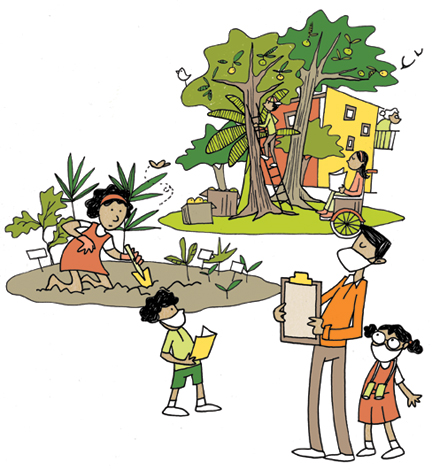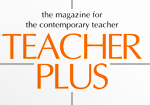Neha Pradhan Arora
For the last two years, school has meant a device and classrooms have been limited within screens for most children in India. According to data from UNESCO India is second only to Uganda with regard to the longest pandemic-induced school closure. When some age groups were able to begin school last year, various models of online, blended or hybrid teaching evolved which made it possible for learning interactions to continue. While we have all experienced the challenges of the last two years, it is critical that we gauge and build our readiness to adapt to physical classrooms again.
What has changed during the last two years in teaching-learning?
Our notion of the classroom has changed during the last two years. As teachers and educators, our realization that children can learn even when they are outside the four walls of what was our classroom but in a virtual space, at home and in real world situations; is the real turning point. I have heard teachers express surprise when they see test results or projects or participation in class. While we spent a large part of the first year of the pandemic replicating in-person teaching processes and struggling with technology or student disinterest, educators soon began to experiment with technological tools, flipped methods and projects to make the teaching-learning more effective. Our understanding and awareness of how all of us – both adult and children learn also changed. Our interactions have changed. We’ve learnt to focus on individuals, what they are saying or not saying. We have learnt to listen.
With these lessons, what we need to be cognizant of now, is that the needs of our learners have also changed. As they return to school, their need for interaction and connection is higher than anything else. Their need for expression of fear, anxiety, grief and their need for hope and purpose is what will build a sense of safety and wellbeing around them.
While being in school, getting back to routine, following schedules, being with their peers will all help build this sense of safety and well-being, using experiential tools and methods that encourage student agency and expression is critical. Not only will these help to fulfil the socio-emotional needs of the students, they will also ensure attentive engagement, contextual and purposeful learning.

Experiential tools include activities that may be designed and executed with or by learners, in the classroom, outdoors or even virtually; followed by reflection on the experience to assimilate and apply the learning. While there are experiences that children can work on independently, group experiences, especially after the last two years, will encourage peer and collaborative learning. How will group experiences be possible or effective in the context of masks and physical distancing? How will experiences work in the hybrid model?
Experiential Learning – purpose, process
Before we answer these questions, let us take a closer look at the elements of experiential learning. According to David Kolb’s cycle of experiential learning, there are four key elements to any learning experience –
• Concrete experience – doing /having the experience.
• Reflective observation – reviewing or reflecting on the experience.
• Abstract conceptualization – concluding or learning from the experience.
• Active experimentation – applying what one has learnt to new contexts.
It is important to keep in mind all these elements while planning learning experiences in our classrooms. Activities we plan are usually just the first stage of the experience. The reflection, learning and application is what makes it an effective learning experience.
Learning experiences will have to be adapted, based on Covid safety protocol for learners in classrooms or how many are attending online. Let us try and explore the different kinds of learning experiences that would be possible, feasible and beneficial.
- Group work on real world projects
Projects that require groups to collect information through research, survey or interview and then analyze and compile it in the context of a real world problem are purposeful and contextual activities. When this is followed by reflection and review within a group and individually, it becomes a learning experience. The project can be based on a school problem such as ‘how can all classes be accommodated in a facility like the music room keeping in mind Covid protocol’ or a neighbourhood problem like ‘what is the impact of wrongful disposal of masks in our locality and how can we ensure they are disposed of appropriately?’ - Activities or tasks done at home and then compiled or reflected upon as a group to create a group presentation
Science experiments, interviews for literature, capturing the oral history of a family member who was present at a historical national event, food explorations, audits (waste/water), journals for specific tasks… there are numerous skill-based tasks, based on curricular concepts that can be done by learners in the safety of their home and then reviewed and shared within groups to assimilate the learning before it is shared collectively. - Discussions on shared experiences – movies / books / lived experiences
Enriching, reflective discussions are an effective way to engage with learners especially those in middle and senior school. While there may not be enough time to show an entire movie during class, showing a scene, followed by the learners watching the movie at home, followed by a reflective sheet or task (in class) and a discussion is also possible. This is especially useful for intangible concepts and emotions that may be themes in literature or social science. Some of these may be connected to our own lived experiences of the last two years – isolation, loss, fear, grief – and creating a safe space for learners to be able to express and share will help in the collective healing of the class while building a deeper sense of connectedness. - Virtual interactions and experiences
Continuing to use technology to our advantage, especially to connect with people and places that are far away will also help in creating learning experiences in the classroom. These could include interactions with experts, virtual tours or demonstrations and even interactions as part of collaborative programmes across regions / spaces / countries. - Experiences in outdoor spaces – games, activities, field trips
Being outdoors is something we missed in the first year of the pandemic and then tried to do more of it as the pandemic continued. It would be a safer space to conduct experiences for groups of children and will also give everyone the much needed break from the screens. Nature trails, visiting a natural resource (river / pond / forest) or even doing a game / group activity in the outdoor space in school, rather than indoors can be the first step towards an effective learning experience.

While those not being able to attend physical school may miss out on the group experience, it may be possible for the teacher to ask them to replicate the same in their home/terrace/garden/park as much as possible. They must however be a part of the reflection or review discussions and may be given other tasks to add to the learning process.
- Community engagement
This element of experiential learning has suffered a great deal even at a time when this was what we needed the most. The possibility of doing this in person still comes with risk for unvaccinated children. However, creative and innovative ideas like an outdoor sports event with a local school, a tree-plantation with local species around the school periphery, creating bags from old t-shirts / shorts and distributing these items to others in the neighbourhood, outdoor story reading for children in the neighbourhood, doing chores for senior citizens who may be living alone, organizing outdoor programmes for support staff in neighbourhoods, running a campaign for COVID appropriate behaviour or vaccination in an outdoor public space… these are some of the many ways in which opportunities for learners to engage with their own community and try to fulfil the needs of the same, can be created.
All of these are possible and can be designed keeping in mind that learners must be masked and keep adequate distance or work outdoors. Or that some learners may be online and not in school. What is essential is the clarity of purpose and the planning of the same. While the experiences must be linked to academic or curricular spaces, it is critical that we acknowledge the role experiential learning plays in strengthening peer connections, creating student agency, facilitating reflective expression and ensuring attentive engagement. Integrating conversations, mindfulness, games and elements of play or the arts; natural and outdoor spaces within the daily schedule of the school and the academic routine of the class will be necessary to help learners adjust to in-person classrooms again. They will also give educators the much needed help and support in dealing with the transition themselves.
The last two years have taken a toll on all of us – teachers, learners, parents, staff – all of us have suffered individually and collectively. We must be prepared for this realization to start sinking in as we go back to some kind of normalcy with schools reopening. We must be ready to pause, listen and give ourselves the time we need to adapt without expecting everyone to bounce back in the same way. We must ensure that along with learning, our classrooms also focus on healing, on recovering and on strengthening individuals as well us the collective.
The author has worked in the education and development sector for close to 20 years towards building safer, inclusive and resilient communities. Using dialogue and experiential tools with children, young adults and schools to build their capacities towards becoming responsible leaders for their own communities is what drives her. She can be reached at neha.learningcommunities@gmail.com.
Related Article
